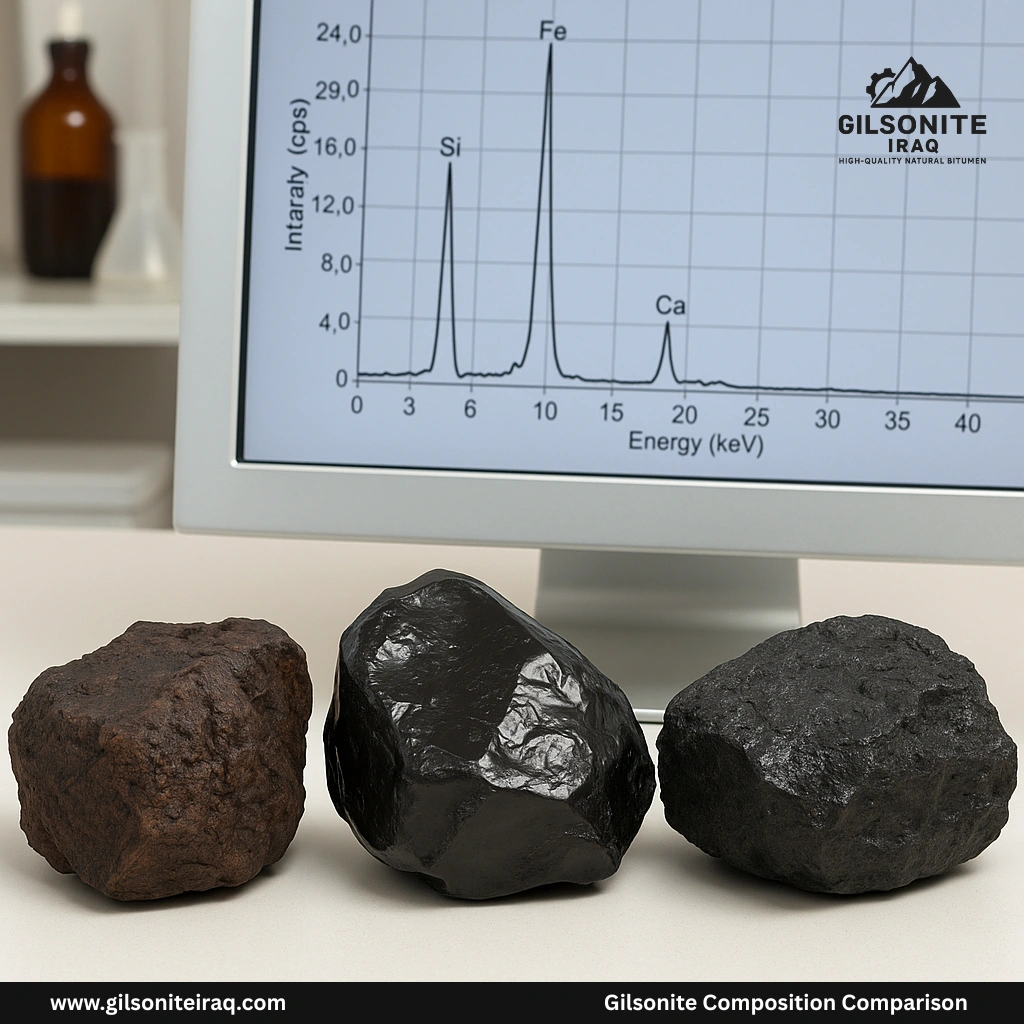Gilsonite — also known as natural asphalt or uintaite — is a naturally occurring hydrocarbon mineral found in a few regions of the world, notably Iraq, Iran, and the United States (Utah).
Although all Gilsonite deposits share the same general hydrocarbon structure, their chemical composition can vary significantly based on geological formation, depth, and maturation conditions.
Understanding these differences is crucial for industries such as asphalt modification, drilling fluids, foundry, ink, and resin manufacturing, where chemical composition determines performance.
This article provides a comparative analysis of Iraqi, Iranian, and American Gilsonite grades based on laboratory data, XRF and FTIR analyses, and their implications for industrial use.
1. Overview of Gilsonite Composition
Gilsonite is primarily composed of asphaltenes, resins, and a small portion of saturates and aromatic hydrocarbons.
It also contains trace minerals and ash-forming elements such as iron, silica, and calcium oxide.
The ratio between asphaltenes and resins dictates key physical characteristics — hardness, softening point, solubility, and thermal behavior.
| Component | Typical Function |
|---|---|
| Asphaltenes | Provide hardness, thermal stability, and high softening point |
| Resins | Improve flexibility, adhesion, and solubility |
| Volatiles | Influence melting range and viscosity |
| Ash / Minerals | Reduce purity and may affect dispersion |
2. Comparative Chemical Analysis
The following table summarizes the key compositional differences between Gilsonite from Iraq, Iran, and the USA based on available analytical studies (ASTM and XRF methods):
| Property | Iraqi Gilsonite | Iranian Gilsonite | American Gilsonite (Utah) |
|---|---|---|---|
| Carbon Content (%wt) | 85–88 | 82–85 | 81–84 |
| Hydrogen Content (%wt) | 8–10 | 9–11 | 10–12 |
| Sulfur Content (%wt) | 0.2–0.6 | 0.5–1.0 | 0.3–0.8 |
| Ash Content (%wt) | 3–6 | 5–8 | 4–7 |
| Asphaltene Fraction (%wt) | 65–75 | 55–65 | 50–60 |
| Resin Fraction (%wt) | 15–20 | 20–25 | 25–30 |
| Softening Point (°C) | 185–220 | 165–200 | 160–190 |
| Solubility in CS₂ (%wt) | 98–99 | 95–98 | 95–97 |
Interpretation:
The higher asphaltene and carbon content of Iraqi Gilsonite make it inherently harder, purer, and more thermally stable.
In contrast, American and Iranian grades, while suitable for general industrial use, show slightly lower softening points and higher volatile content — making them less ideal for high-temperature or high-performance applications.
Source: ScienceDirect, ASTM
3. Spectroscopic Characterization (FTIR Analysis)
Fourier Transform Infrared (FTIR) spectroscopy reveals the functional groups present in Gilsonite samples.
Typical spectra show strong absorbance in the following regions:
| Wavenumber (cm⁻¹) | Functional Group | Effect |
|---|---|---|
| 2920–2850 | C–H stretching (aliphatic hydrocarbons) | Base structure |
| 1600–1650 | C=C aromatic ring vibrations | Increases rigidity |
| 1370–1450 | CH₂ bending | Indicates polymeric structure |
| 1030–1100 | C–O–C stretching | Oxygenated compounds |
| 700–900 | Aromatic C–H bending | Indicates condensed ring systems |
Comparatively, Iraqi Gilsonite shows stronger aromatic C=C peaks and fewer oxygenated compounds — suggesting higher maturity and lower oxidation levels.
This means it resists degradation and oxidation during blending with bitumen or exposure to air.
4. XRF Elemental Analysis
X-Ray Fluorescence (XRF) provides insight into the mineral impurities within each type of Gilsonite.
Below is a summary of common inorganic constituents:
| Element | Iraqi Gilsonite (%wt) | Iranian (%wt) | American (%wt) |
|---|---|---|---|
| SiO₂ | 1.2 | 2.4 | 2.1 |
| Fe₂O₃ | 0.8 | 1.5 | 1.2 |
| CaO | 0.5 | 0.7 | 0.9 |
| Al₂O₃ | 0.6 | 0.8 | 0.8 |
| TiO₂ | 0.1 | 0.2 | 0.2 |
The lower silica and iron oxide content in Iraqi Gilsonite translates to less ash residue and better solubility during bitumen or drilling fluid blending.
5. Thermal Behavior Correlation
Due to its superior carbon and asphaltene ratio, Iraqi Gilsonite maintains a softening point 15–25°C higher than other grades.
This directly correlates with improved rutting resistance in asphalt, stability in oil-based muds, and lower oxidative degradation.
Thermal analysis (TGA/DSC) indicates that Iraqi Gilsonite decomposes above 450°C, compared to 400°C for Iranian and 380°C for American samples — confirming its higher thermal maturity.
6. Industrial Implications
| Industry | Effect of High Asphaltene / Low Ash |
|---|---|
| Asphalt and Bitumen | Higher rutting resistance, better adhesion, improved thermal stability |
| Oil Drilling Fluids | Enhanced sealing and fluid loss control under HPHT conditions |
| Foundry & Casting | Cleaner burn-out, fewer residues |
| Ink & Resin | Improved carbon density, color stability, and gloss |
| Carbon Materials | Higher fixed carbon yield and graphitization potential |
These properties make Iraqi Gilsonite the preferred grade for industries that demand both purity and performance — particularly in high-temperature environments.
7. Comparative Performance Summary
| Feature | Iraqi | Iranian | American |
|---|---|---|---|
| Thermal Stability | ★★★★★ | ★★★★☆ | ★★★★☆ |
| Purity (Low Ash) | ★★★★★ | ★★★☆☆ | ★★★★☆ |
| Oxidation Resistance | ★★★★★ | ★★★★☆ | ★★★☆☆ |
| Solubility | ★★★★★ | ★★★★☆ | ★★★★☆ |
| Industrial Versatility | ★★★★★ | ★★★☆☆ | ★★★★☆ |
Conclusion
The chemical composition of Iraqi Gilsonite demonstrates clear superiority over Iranian and American grades in terms of purity, carbon concentration, and asphaltene richness.
These characteristics make it exceptionally thermally stable, oxidation-resistant, and ideal for demanding applications such as asphalt modification, drilling, and resin production.
As global industries shift toward high-performance and environmentally responsible materials, Iraqi Gilsonite continues to stand out as a premium natural asphalt source with unmatched quality and consistency.


